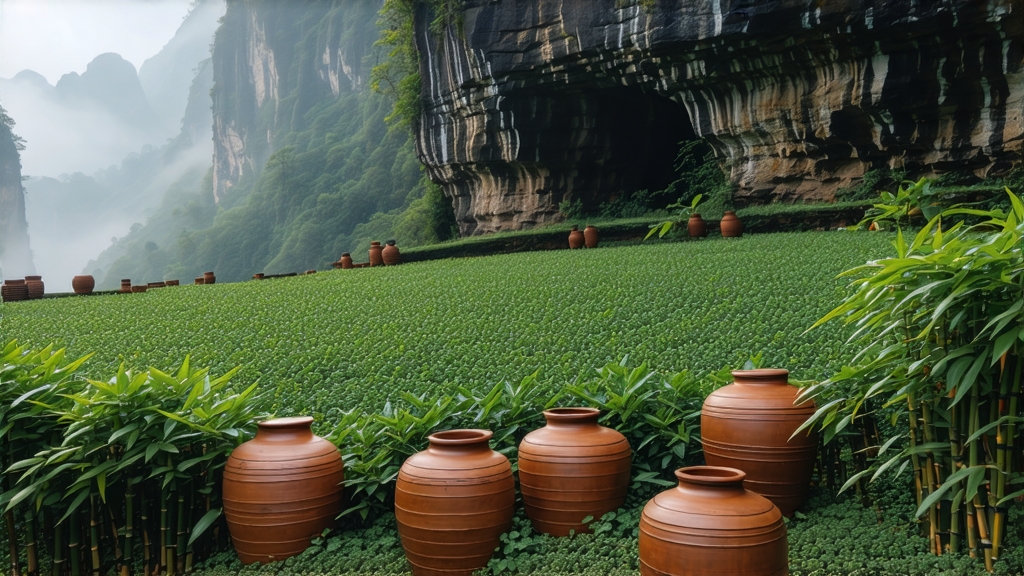
Tucked into the crevices of Guangxi’s karst mountains, Liu Bao cha has spent four centuries quietly transforming itself from a coolie’s thirst-quencher into one of the most nuanced dark teas on earth. International drinkers who think “Chinese black tea” means Keemun or Lapsang soon discover that Liu Bao belongs to the separate hei cha (dark tea) family, a class defined not by leaf colour but by post-fermentation. What sets Liu Bao apart is its journey through humid bamboo baskets, riverside warehouses and finally the natural caves that act both as cradle and time capsule. The result is a liquor that smells of damp camphor wood, tastes of longan honey, and finishes with the minerality of limestone water that once carried it to Southeast Asia on clipper ships.
History: from border tonic to maritime currency
The name simply means “Six Forts,” a string of Ming-dynasty garrisons along the Wuzhou trade corridor where Yunnan, Guangdong and Guangxi meet. Caravans plying the Pearl River needed a tea that would survive months of heat without molding, so locals learned to steam, pile and basket-press their coarse leaves. By 1680 Liu Bao was ballast in the hulls of junks bound for Malacca, where it became the breakfast drink of tin miners and the unofficial currency of the kongsi plantations. In 1886 the British consul in Singapore noted that “the coolie will accept no other leaf; he says it keeps fever away.” When rubber replaced tin, Indian teas captured the docks and Liu Bao slipped into obscurity—until the 2005 renaissance when Malaysian collectors discovered that 1950s baskets were trading for more than pu-erh cakes of equal age.
Micro-terroirs inside one province
Although the official GI limits Liu Bao to Wuzhou City, growers recognise three meso-zones. The eastern lowlands around Daqiao town give broad, fast-growing leaves that turn sweet and red after three years. The central basin of Liucheng, fed by limestone springs, yields smaller leaves rich in amino acids; after cave aging they develop the prized “betel nut” note. Finally the western cloud-zone at 600–800 m, where the same Dai minority villages that once fed the garrisons still propagate ancient seed-stock bushes. These high-leaf teas carry more geraniol, the compound responsible for the cooling camphor finish that collectors liken to old sandalwood cabinets.
Craft: the dance of steam, pile and cave
Harvest begins in late April, when three leaves and a bud have toughened enough to withstand the arduous process. The first step is “kill-green” in a 200 °C wok for exactly 90 seconds—long enough to denature polyphenol oxidase but short enough to preserve leaf integrity. Immediately the leaves are rolled into tight strips, then steamed for 15 minutes to soften cellulose before being packed into 40 kg bamboo baskets lined with banana leaf. Here the tea undergoes wet-pile fermentation: the baskets are stacked in riverside sheds where humidity hovers at 85 % and temperature at 28 °C for 25–45 days, depending on the master’s nose. Every third night the piles are flipped, allowing anaerobic microbes to dominate and create the characteristic “golden flowers” (Eurotium cristatum) that bloom like tiny yellow stars on the leaf surface. Finally the baskets are moved to natural caves whose constant 20 °C and 75 % humidity let the tea breathe through the bamboo slats while limestone filters any off-odours. A 1950s vintage can spend sixty years in the same basket, losing 38 % of its weight yet gaining layers of camphor, longan and pipe tobacco.
Grades & shapes
Unlike pu-erh’s cake obsession, Liu Bao is sold by basket weight. The top grade, “Special Song,” uses only the first two leaves and is pressed into 500 g “tuo” nests for the Malaysian gift market. “First Grade” keeps the third leaf and remains in the traditional 40 kg basket; this is the collectors’ favourite because the bamboo imprint creates micro-channels for continued aging. “Third Grade” includes stems and is often double-fermented for the Hong Kong restaurant trade, yielding a darker, coffee-like liquor that stands up to dim-sum fats. A recent innovation is the “slender brick,” a